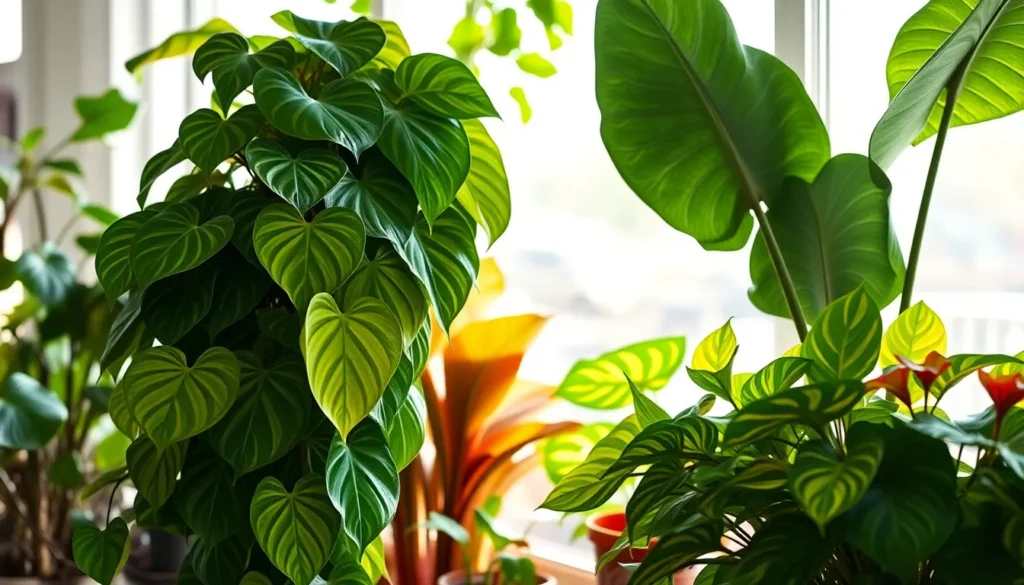We’ve all fallen under the spell of philodendrons – those gorgeous trailing and climbing houseplants that transform any space into a lush indoor jungle. With their heart-shaped leaves and incredible adaptability, these tropical beauties have become the crown jewels of plant collections worldwide.
What makes philodendrons truly special isn’t just their stunning appearance but their remarkable diversity. From the classic Heartleaf Philodendron with its cascading vines to the dramatic Philodendron Monstera with its split leaves, there’s a variety that’ll perfectly match your space and style. Whether you’re a beginner plant parent or a seasoned collector, understanding the different types helps you choose the perfect green companion.
Heart-Leaf Philodendron (Philodendron Hederaceum)
Heart-Leaf Philodendrons earn their name from their distinctive heart-shaped leaves that cascade beautifully from hanging baskets or climb up moss poles. We consider this variety the perfect starting point for philodendron enthusiasts due to its forgiving nature and stunning trailing growth pattern.
Care Requirements and Growing Conditions
Light conditions for Heart-Leaf Philodendrons thrive in bright, indirect sunlight but tolerate lower light situations remarkably well. Direct sunlight can scorch the delicate leaves, so we recommend placing them near east or north-facing windows.
Watering schedules should follow the “soak and dry” method, allowing the top inch of soil to dry between waterings. Overwatering causes root rot, while underwatering leads to droopy, yellowing leaves.
Temperature ranges between 65-78°F create optimal growing conditions, though these adaptable plants handle temperatures as low as 60°F. Avoid placing them near heating vents, radiators, or drafty windows.
Humidity levels around 40-50% support healthy growth, but Heart-Leaf Philodendrons adapt to average household humidity. Misting leaves occasionally or using a pebble tray increases moisture around the plant.
Soil requirements include well-draining potting mix with peat moss, perlite, or bark chips for proper aeration. Standard houseplant soil works perfectly when amended with these drainage materials.
Popular Varieties and Color Variations
Classic Green Heart-Leaf Philodendrons feature deep emerald leaves with glossy surfaces that reflect light beautifully. This traditional variety remains the most common and affordable option in most nurseries.
Brasil Philodendron displays stunning variegation with golden yellow stripes running through each heart-shaped leaf. The variegated patterns create unique color combinations that make each plant distinctly beautiful.
Micans variety produces velvety, bronze-tinted leaves with purple undersides that shimmer in changing light conditions. Young leaves emerge bright green before developing their characteristic metallic appearance.
Lemon Lime cultivar showcases bright chartreuse foliage that adds vibrant color to any plant collection. New growth appears almost neon yellow before maturing to a softer lime green shade.
| Variety | Leaf Color | Special Features | Light Needs |
|---|---|---|---|
| Classic Green | Deep emerald | Glossy surface | Low to bright indirect |
| Brasil | Green with yellow stripes | Variegated patterns | Bright indirect |
| Micans | Bronze with purple undersides | Velvety texture | Moderate to bright indirect |
| Lemon Lime | Bright chartreuse | Neon new growth | Bright indirect |
Split-Leaf Philodendron (Monstera Deliciosa)
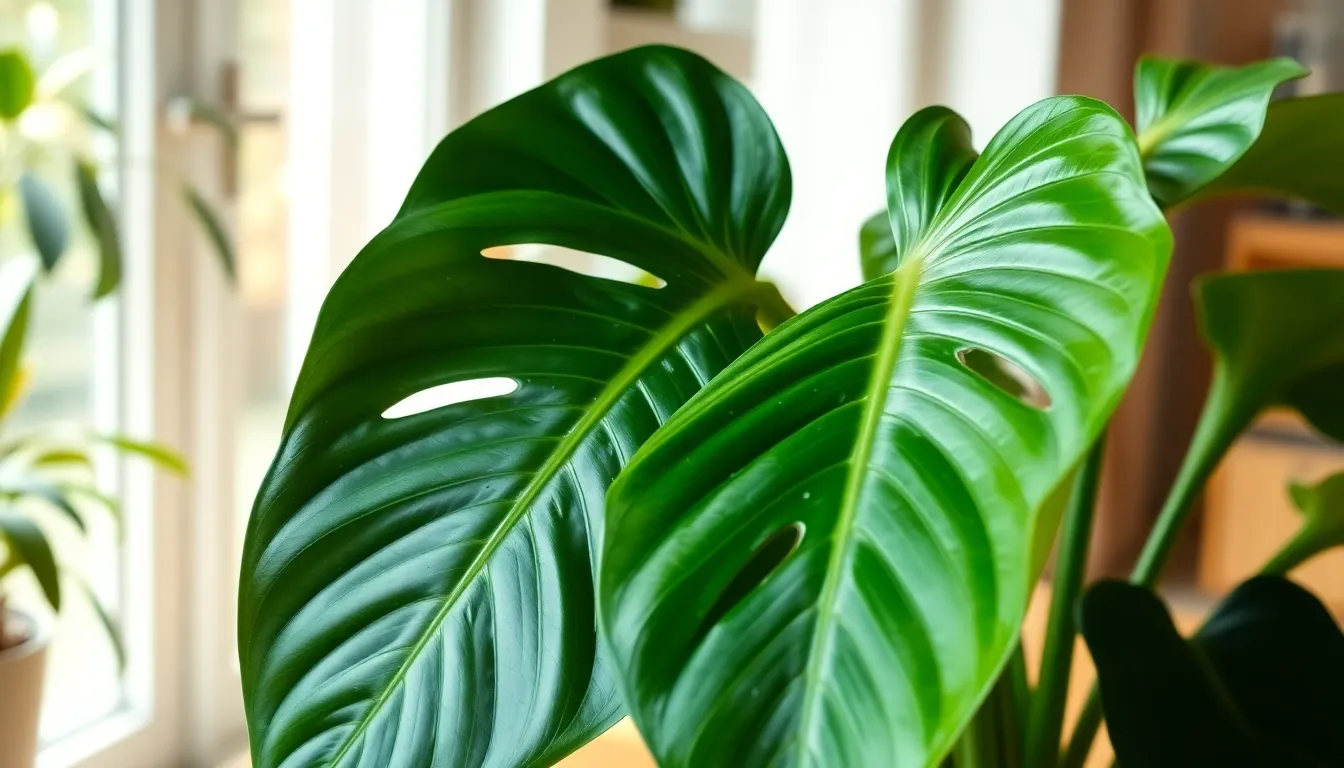
Moving beyond the classic heart-shaped varieties, we encounter one of the most striking philodendrons in cultivation. The Split-Leaf Philodendron, scientifically known as Monstera deliciosa, captivates plant enthusiasts with its large, glossy green leaves that develop natural splits and holes as they mature.
Distinctive Fenestration Patterns
Fenestrations transform ordinary leaves into botanical masterpieces through their unique development process. These natural splits and holes begin appearing on mature Monstera deliciosa leaves, creating the iconic “Swiss cheese” appearance that’s made this plant so recognizable.
Pattern formation occurs irregularly across each leaf, ensuring no two leaves look exactly alike. Small splits start developing first, gradually expanding into larger holes as the plant continues growing.
Nature designed these fenestrations for survival in dense tropical rainforests. The holes allow light to pass through to lower leaves while helping the plant withstand strong winds in its native environment.
Each fenestration tells a story of the plant’s maturity level. Younger plants produce solid leaves, while older specimens showcase increasingly dramatic splits and holes that make them conversation starters in any room.
Indoor vs Outdoor Growing Tips
| Growing Condition | Indoor Requirements | Outdoor Requirements |
|---|---|---|
| Light | Bright, indirect light | Partial shade |
| Sun Exposure | Avoid direct sunlight | Protect from afternoon sun |
| Humidity | Maintain moderate humidity | Requires warm, humid environment |
| Temperature | Room temperature | No frost tolerance |
| Support | Optional moss pole | Climbing structures needed |
Indoor cultivation offers better control over environmental conditions for most gardeners. We recommend placing your Monstera deliciosa in bright, indirect light to prevent leaf burn while maintaining healthy growth.
Watering practices differ significantly between indoor and outdoor settings. Indoor plants need moderate watering with soil drying slightly between sessions, while outdoor specimens may require more frequent attention depending on climate conditions.
Outdoor growing demands exact considerations that indoor cultivation doesn’t require. Your plant needs protection from strong winds and direct afternoon sun, plus you’ll need to provide support structures for its natural climbing tendencies.
Soil requirements remain consistent regardless of location. Well-draining soil prevents root rot, though outdoor plants benefit from slightly richer organic matter to support their larger growth potential.
Fertilization schedules vary based on growing conditions. Indoor plants benefit from occasional feeding during growing season, while outdoor specimens may need more regular nutrition to support their accelerated growth.
Philodendron Brasil
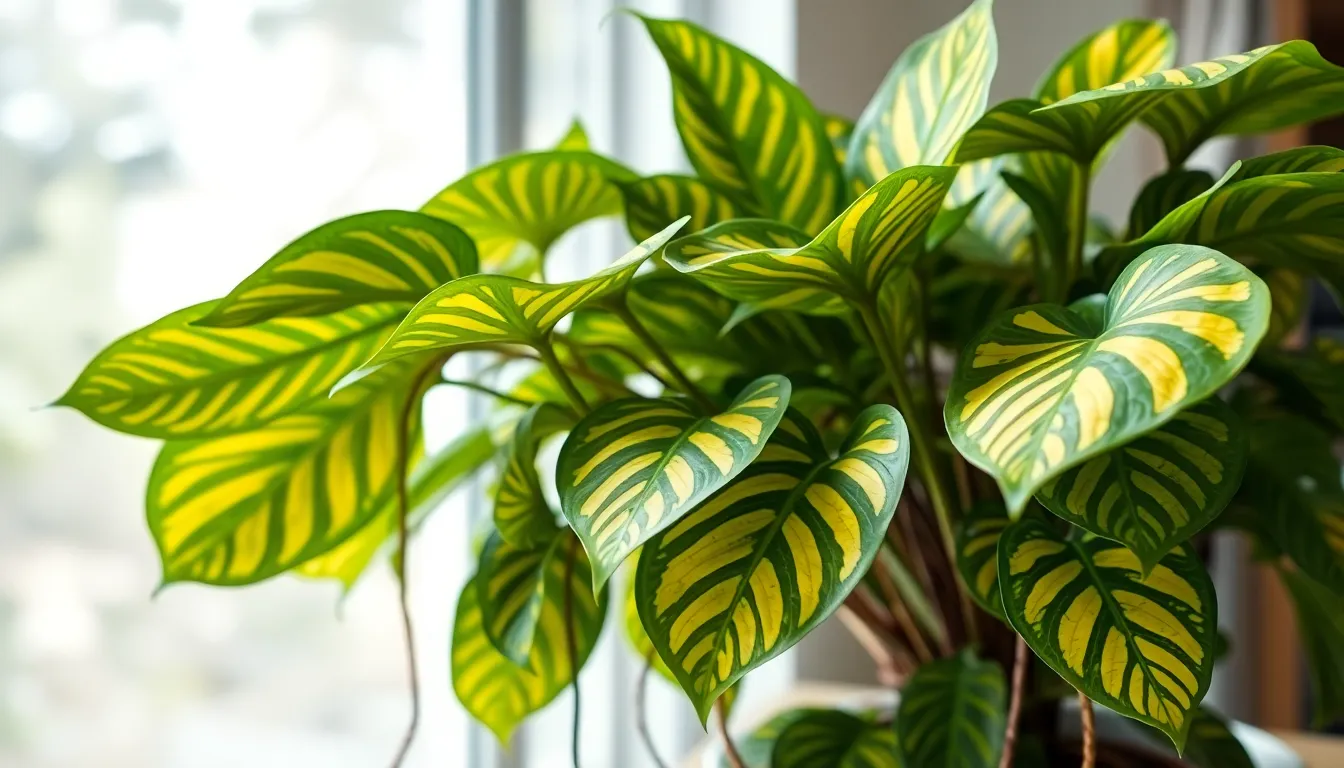
We consider the Philodendron Brasil one of the most stunning variegated trailing varieties available to houseplant enthusiasts. This popular cultivar brings vibrant color patterns and easy care requirements together in a perfect combination for both beginners and experienced growers.
Variegated Foliage Characteristics
Variegated patterns in Philodendron Brasil create striking visual appeal through green and yellow streaks across heart-shaped leaves. The yellow markings lack chlorophyll, making these sections sensitive to light conditions and requiring careful placement to maintain their vibrant appearance.
Bright indirect light helps preserve the plant’s colorful variegation while preventing leaf burn from direct sunlight exposure. We’ve observed that insufficient lighting often causes the plant to revert to solid green leaves as it prioritizes chlorophyll production for survival.
Stability of the variegated patterns depends on environmental factors like light availability and plant stress levels. When conditions become unfavorable, such as during periods of low light or environmental stress, the Brasil variety may produce predominantly green foliage instead of its characteristic yellow and green combination.
Propagation Methods
Stem cutting propagation works exceptionally well for Philodendron Brasil, making it easy to multiply your collection or share with fellow plant lovers. We recommend selecting healthy stems with several visible nodes, which are the leaf joints where roots will eventually develop.
Water propagation offers the simplest approach for beginners, requiring you to place cut stems in clean water until roots emerge from the nodes within several weeks. Alternatively, you can plant cuttings directly into moist soil for those who prefer soil propagation methods.
Timing your propagation efforts during spring and summer ensures the best success rates when the plant experiences active growth periods. Warm temperatures, high humidity, and bright indirect light create optimal conditions for root development during the propagation process.
Air layering and division methods provide additional propagation options, though stem cuttings remain the most straightforward and reliable technique for home growers. These alternative methods work particularly well for larger, more established plants that have developed multiple growing points.
Pink Princess Philodendron (Philodendron Erubescens)
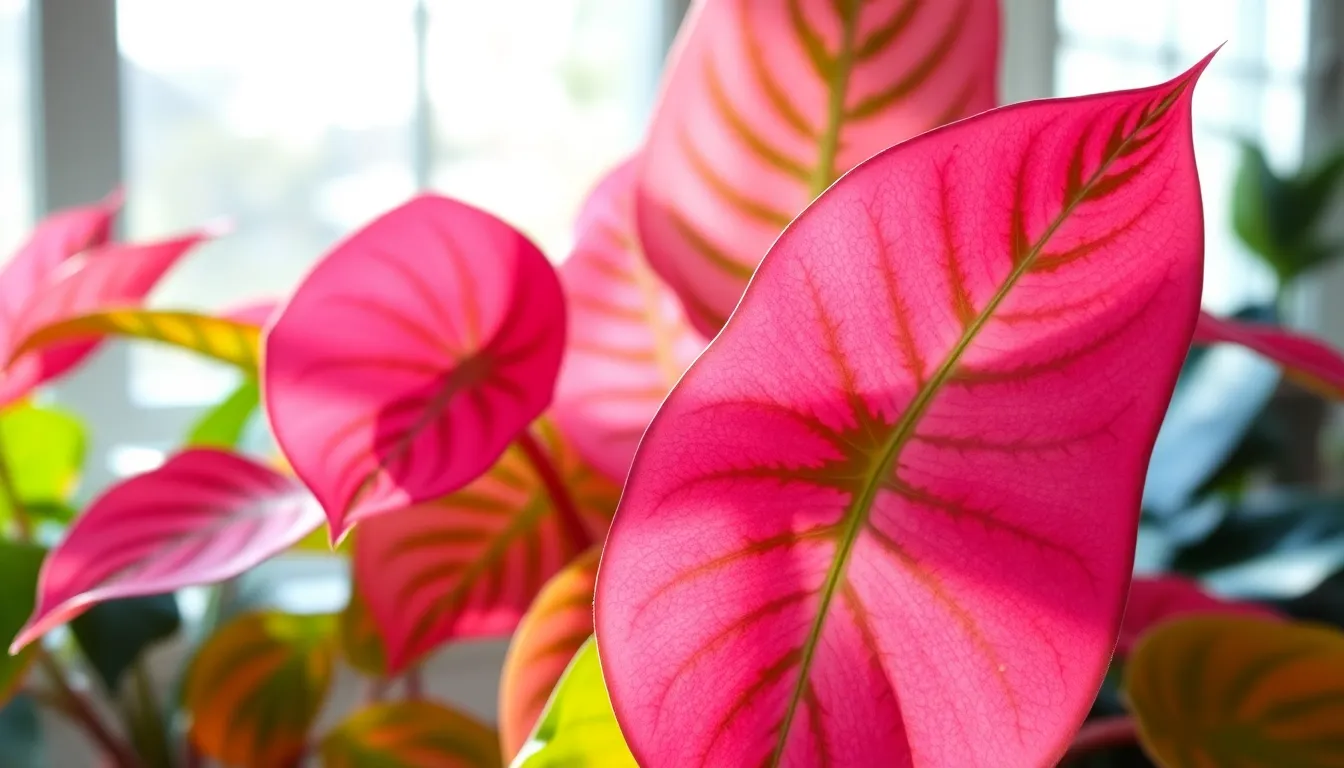
Among the most coveted philodendron varieties, the Pink Princess stands out with its naturally occurring pink variegation that creates stunning visual appeal. We consider this vining philodendron a true showstopper that typically reaches 4 to 5 feet tall in indoor settings.
Pink Variegation Patterns
Pink Princess Philodendrons display heart-shaped leaves where vibrant pink and green colors intermingle in unique patterns across each leaf surface. Nature creates these striking variegations spontaneously, ensuring that no two leaves appear exactly identical in their pink distribution. Green sections provide the plant’s photosynthetic foundation while pink areas add the decorative element that makes this variety so desirable.
Variegation intensity varies naturally from leaf to leaf, with some displaying bold pink sections and others showing subtle pink hints throughout the green foliage. Each new leaf unfurls with anticipation as we never know exactly how much pink will appear in the emerging growth.
Light Requirements for Color Development
Adequate indirect light proves essential for maintaining the Pink Princess’s vibrant pink coloration, as insufficient lighting causes the pink variegation to fade significantly. We recommend placing these plants near bright windows with filtered sunlight to preserve their stunning color display. Direct sunlight burns the delicate leaves and damages both the pink and green portions of the foliage.
Proper light management directly influences the intensity of pink variegation that develops in new growth. Low light conditions not only diminish existing pink coloration but also encourage the plant to produce more green leaves as it attempts to maximize photosynthesis for survival.
Philodendron Micans
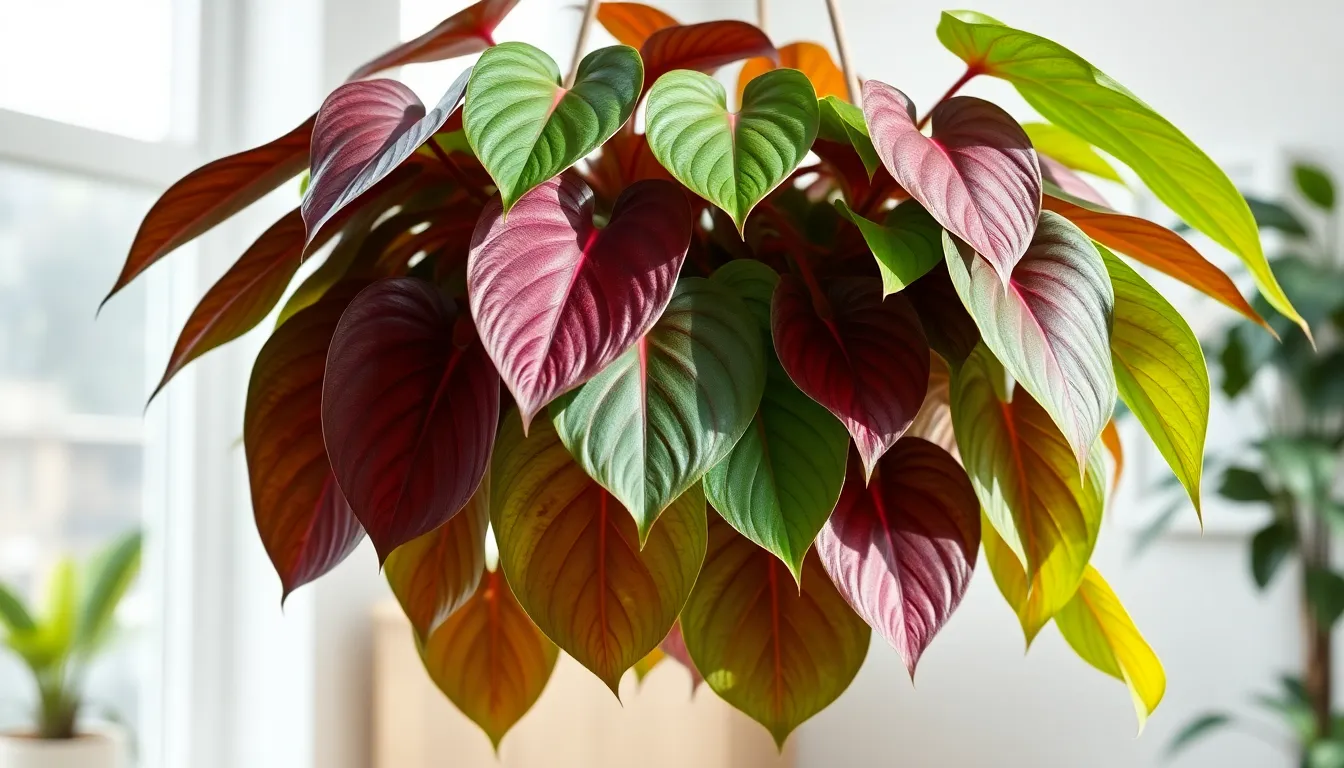
We’ve discovered that Philodendron Micans stands out as one of the most tactile and visually stunning varieties in our collection. Its unique characteristics make it a perfect addition for plant enthusiasts seeking something truly special.
Velvety Leaf Texture Features
Distinctive heart-shaped leaves with velvety texture set Philodendron Micans apart from other varieties in our experience. Fine hairs cover the entire leaf surface, creating that signature soft, plush feeling that makes this plant irresistible to touch.
Stunning light reflection occurs when natural or artificial light hits these velvety leaves. The fine hairs create a beautiful shimmering effect that changes throughout the day, giving your space ever-changing visual interest.
Tactile appeal becomes immediately apparent when you run your fingers across the leaf surface. We’ve found that this velvety texture makes Philodendron Micans one of the most interactive plants in any collection, as guests often can’t resist touching the leaves.
Rich burgundy undersides complement the velvety green tops, creating a gorgeous contrast that adds depth to the plant’s appearance. This color combination becomes more pronounced as the plant matures and develops stronger variegation.
Trailing Growth Habits
Cascading vine growth makes Philodendron Micans perfect for hanging baskets or elevated planters where the stems can flow naturally downward. The vines can extend several feet in length, creating dramatic displays that draw the eye.
Climbing support compatibility allows this variety to grow upward when provided with moss poles, trellises, or other structures. We’ve observed that supported Micans develop larger leaves and more robust growth patterns compared to trailing specimens.
Slender stem structure supports the heart-shaped leaves along its length, creating an elegant arrangement that works well in both modern and traditional interior designs. The stems remain flexible throughout the plant’s growth, making them easy to train and position.
Rapid growth rate means you’ll see new leaves emerging regularly during the growing season. We’ve noticed that well-cared-for Micans can produce new growth every few weeks, quickly filling out their designated space with lush foliage.
Tree Philodendron (Philodendron Selloum)
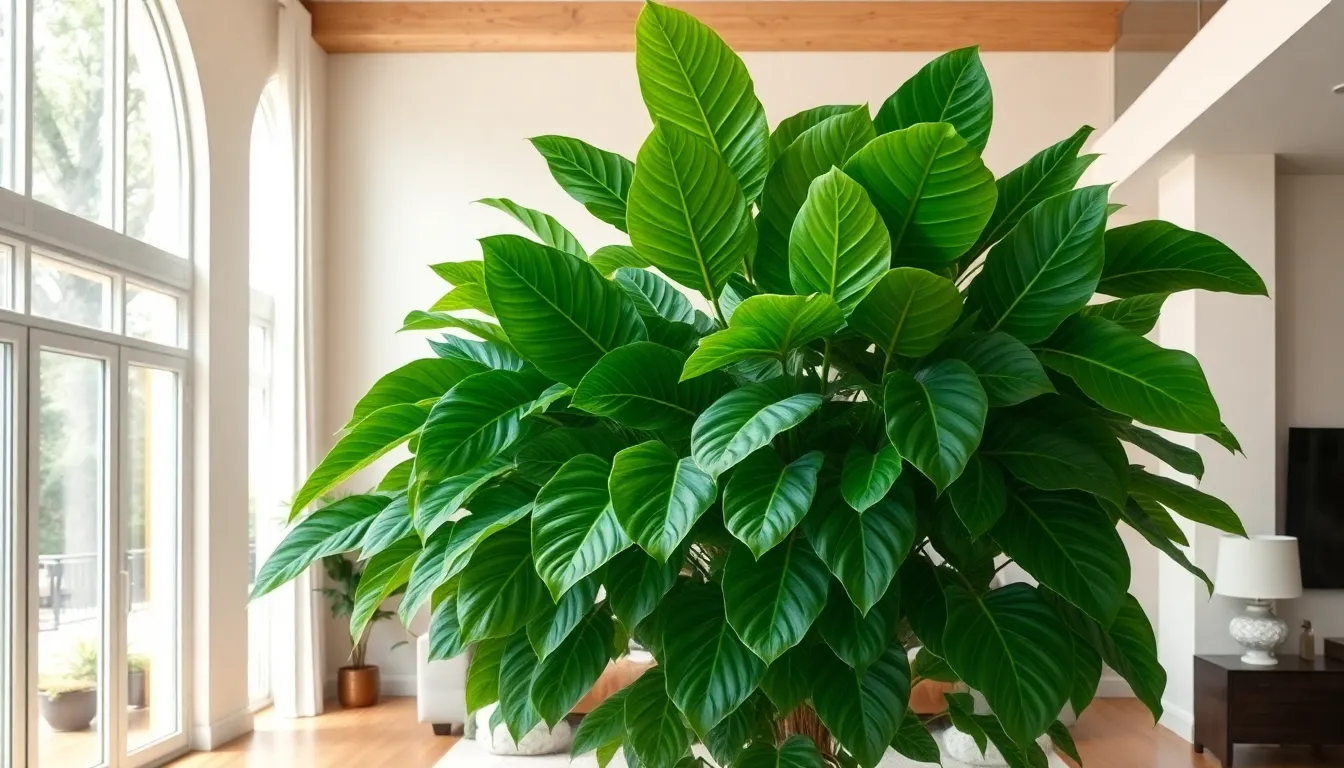
Tree Philodendron stands out as one of the most dramatic philodendron varieties, offering a completely different aesthetic from the trailing varieties we’ve explored. This self-heading plant creates a stunning focal point with its impressive size and architectural presence.
Large Leaf Structure
Large, deeply lobed leaves define the Tree Philodendron’s most distinctive characteristic. Each leaf develops intricate splits and lobes that create a lacy, tropical appearance unlike any other philodendron variety. These massive leaves can reach impressive dimensions, with their split patterns becoming more pronounced as the plant matures.
The foliage emerges with a glossy finish that catches and reflects light beautifully throughout your space. Deep green coloration remains consistent across all leaves, providing a rich backdrop for the plant’s dramatic silhouette. Each new leaf unfurls with increasingly complex lobing patterns, showcasing the plant’s natural evolution as it grows.
Unlike heart-shaped leaves found in trailing varieties, these leaves feature multiple deep cuts that extend from the edges toward the center. This unique leaf structure allows the plant to withstand strong winds in its native habitat while creating an eye-catching display indoors.
Space Requirements for Indoor Growing
Indoor Tree Philodendrons require substantial space to accommodate their impressive growth potential. These plants can reach up to 8 feet tall in containers, making them suitable only for rooms with adequate vertical clearance. We recommend allowing at least 4-6 feet of horizontal space around the plant to accommodate its wide leaf spread.
High ceilings become essential when growing mature Tree Philodendrons indoors, as the plant’s upright growth habit demands vertical room to thrive. Large living rooms, atriums, or spaces with cathedral ceilings provide ideal environments for these statement plants. Regular pruning may become necessary to maintain manageable proportions in smaller indoor spaces.
Consider the plant’s mature size when selecting its permanent location, as moving large specimens becomes challenging once established. Floor space requirements increase significantly as the plant develops, with mature specimens often occupying a 4-foot diameter footprint or more.
Philodendron Xanadu
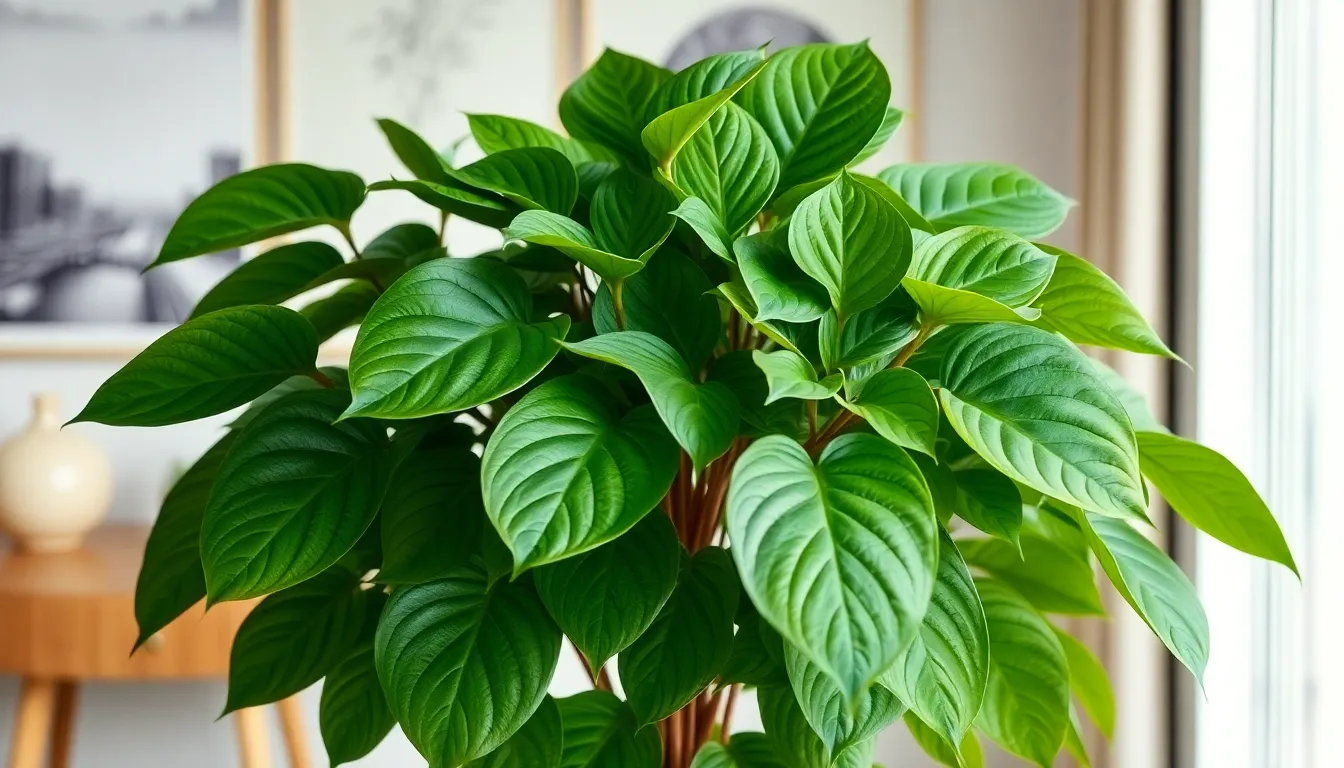
Philodendron Xanadu offers a refreshing departure from the trailing and climbing varieties we’ve explored. This distinctive plant brings architectural beauty to any space with its unique growth characteristics and versatile applications.
Compact Growth Pattern
Compact growth defines the Philodendron Xanadu’s most appealing feature. Unlike vining philodendrons that sprawl across surfaces or climb supports, Xanadu develops as a self-heading plant that forms a dense, organized clump. Dense clusters of deeply lobed, glossy green leaves emerge from the center, creating a symmetrical and manageable silhouette that stays contained within its designated space.
Manageable size makes Xanadu perfect for indoor environments where space is limited. The plant maintains its neat, shrubby form without requiring extensive pruning or training, unlike varieties such as the Tree Philodendron that can reach overwhelming heights. Growth remains predictable and controlled, with new leaves unfurling in an orderly pattern that preserves the plant’s compact structure.
Self-heading growth patterns eliminate the need for climbing supports or hanging arrangements. Each leaf develops from the central growing point, creating a full, rounded appearance that showcases the plant’s natural beauty without additional accessories or maintenance requirements.
Industry and Container Applications
Container gardening becomes effortless with Philodendron Xanadu’s adaptable nature. The plant thrives in both indoor pots and outdoor container arrangements, making it suitable for patios, balconies, or as accent pieces in larger plant collections. Its neat form works exceptionally well in decorative containers where the focus remains on the plant’s natural architecture.
Industry applications showcase Xanadu’s versatility in tropical and subtropical climates. The plant serves as an excellent focal point in garden beds, providing lush greenery that complements other tropical plants without overwhelming smaller specimens. Garden designers frequently use Xanadu as a foundation plant or border accent because of its reliable growth pattern and year-round appeal.
Indoor environments benefit from Xanadu’s ability to maintain its shape and size consistency. Unlike trailing varieties that require regular repositioning or climbing types that outgrow their spaces, Xanadu remains stable and proportionate, making it ideal for offices, living rooms, or any indoor space where consistent appearance matters.
Versatile placement options allow Xanadu to function as both a standalone specimen and part of larger plant arrangements. Its compact growth ensures it won’t compete aggressively with neighboring plants, while its distinctive leaf shape provides visual interest that enhances mixed container displays or garden compositions.
Philodendron Prince of Orange
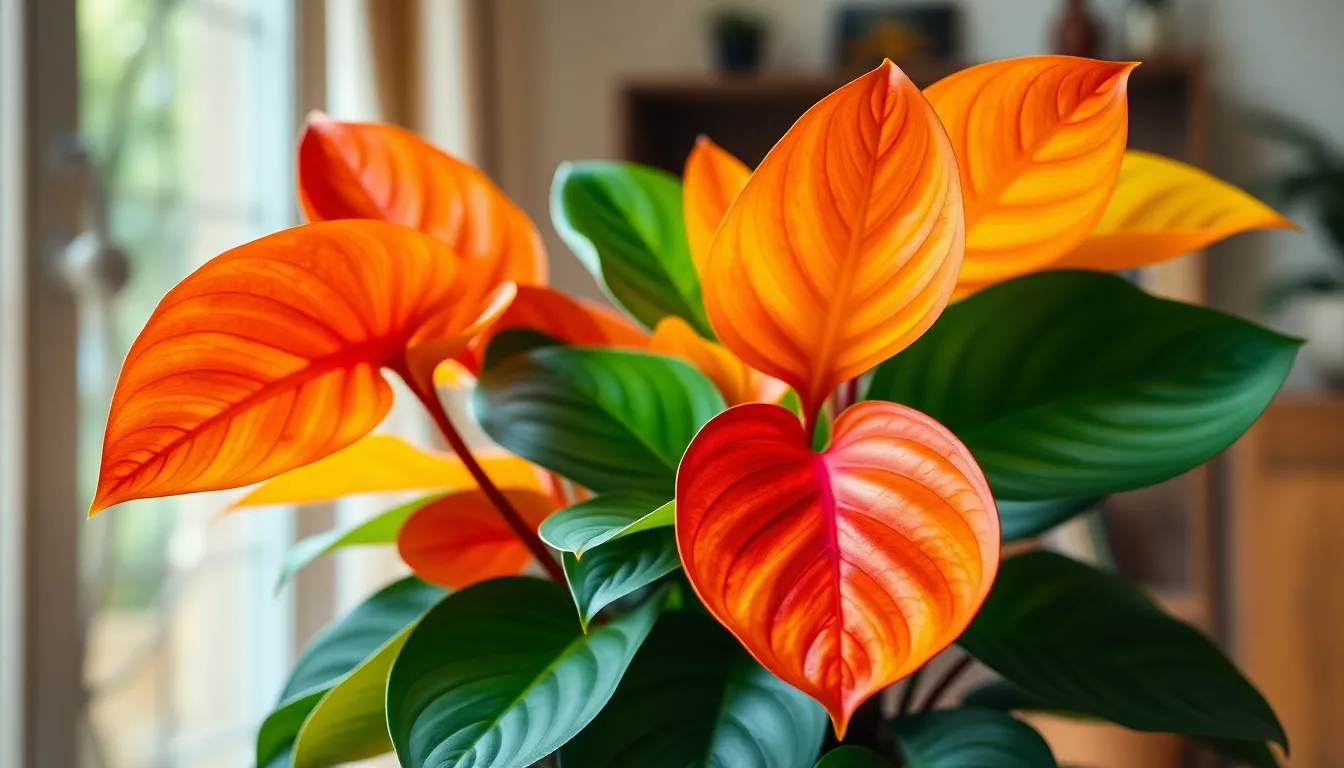
Among the most captivating philodendron varieties, the Prince of Orange stands out for its spectacular color transformations that create a living rainbow in your home. We find this variety particularly rewarding because it offers continuous visual interest as new growth emerges throughout the growing season.
Color-Changing Leaf Development
New leaves burst forth in brilliant orange and reddish hues that immediately catch your attention when they first unfurl from the growing tip. Over several weeks, these vibrant orange leaves gradually transition through a stunning spectrum of colors, shifting from deep orange to lighter orange tones. Yellow pigments begin to emerge as the leaves continue maturing, creating beautiful gradient effects across the foliage.
Green chlorophyll slowly takes over as the final stage of leaf development, transforming the previously colorful leaves into rich emerald green. This natural pigmentation cycle occurs because the plant produces different compounds during various growth phases, with carotenoids creating the orange colors before chlorophyll dominates. Each leaf tells its own story through this color journey, making every Prince of Orange plant a ever-changing display of nature’s artistry.
Temperature and Humidity Needs
Optimal temperatures between 65°F and 80°F (18°C to 27°C) support the most vibrant color development in Prince of Orange philodendrons. We recommend maintaining consistent warmth because temperature fluctuations can stress the plant and potentially dull the intensity of those spectacular orange hues. Cold drafts and temperatures below 55°F (13°C) pose important risks to your plant’s health and can slow down the color changing process.
High humidity levels enhance both the coloration and overall vitality of your Prince of Orange, though these adaptable plants can tolerate average indoor humidity with proper care. Good air circulation prevents moisture related issues while supporting healthy growth patterns that produce more frequent color displays. Avoiding cold drafts while maintaining steady environmental conditions helps ensure your Prince of Orange continues producing those eye catching orange leaves that make this variety so special.
Blushing Philodendron (Philodendron Erubescens)
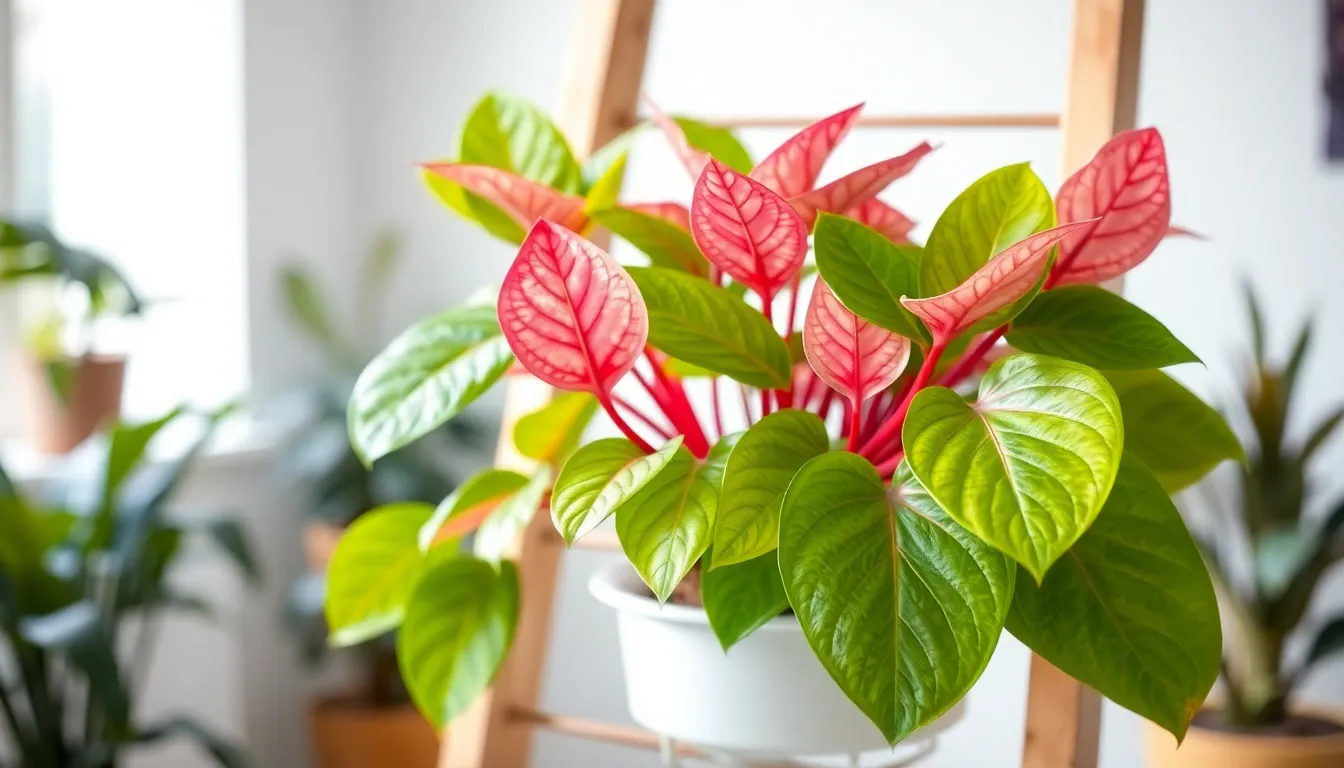
The Blushing Philodendron stands out among types of philodendron plants with its distinctive red stems and glossy heart-shaped leaves that create a stunning visual contrast in any plant collection.
Red Stem Characteristics
Striking red stems define the Blushing Philodendron’s most recognizable feature, displaying purplish-red or deep red coloration throughout the petioles and main stem structure. New growth emerges with an intense pink or red blush that gradually transitions as leaves mature, giving this philodendron variety its common name.
Glossy leaves measure 9 to 18 inches long and showcase dark green upper surfaces with distinctive reddish-copper undersides that complement the vibrant stem coloration. Fresh foliage appears bright red or pink before developing into the characteristic deep green mature coloration, creating a ever-changing color progression throughout the growing season.
Seasonal blooming occurs rarely indoors, though outdoor specimens in ideal conditions produce fragrant deep red spathes with white spadix structures during summer and autumn months. Indoor plants focus their energy on foliage production rather than flowering, maintaining their ornamental appeal through leaf and stem coloration.
Toxic compounds exist within the plant tissue in the form of calcium oxalate crystals, making it essential to wear gloves during pruning and keep the plant away from children and pets. We recommend handling this philodendron variety with proper precautions to ensure safe cultivation practices.
Climbing Support Requirements
Vertical support structures become necessary for Blushing Philodendrons since they naturally grow as climbing perennials that can reach heights of 3 to 6 meters with proper support systems. Moss poles, trellises, or wooden stakes provide the framework needed for optimal vertical growth patterns in indoor environments.
Initial training requires us to tie young stems to support structures since the plant doesn’t automatically attach to all surfaces without assistance. Strategic placement of ties at multiple points along the stem encourages proper climbing behavior and prevents the plant from growing horizontally across available space.
Node rooting occurs when stems make contact with soil or growing surfaces, allowing the plant to establish multiple root systems along its length. This natural adaptation helps the plant secure itself to support structures and access additional nutrients from various soil contact points.
Space considerations become important when choosing between vertical and horizontal growth patterns, as unsupported plants require significantly more horizontal space to accommodate their natural spreading tendency. Training upward through proper support systems maximizes growing space efficiency while maintaining the plant’s impressive size potential of up to 18 meters in optimal outdoor conditions.
Philodendron Hope (Philodendron Bipinnatifidum)
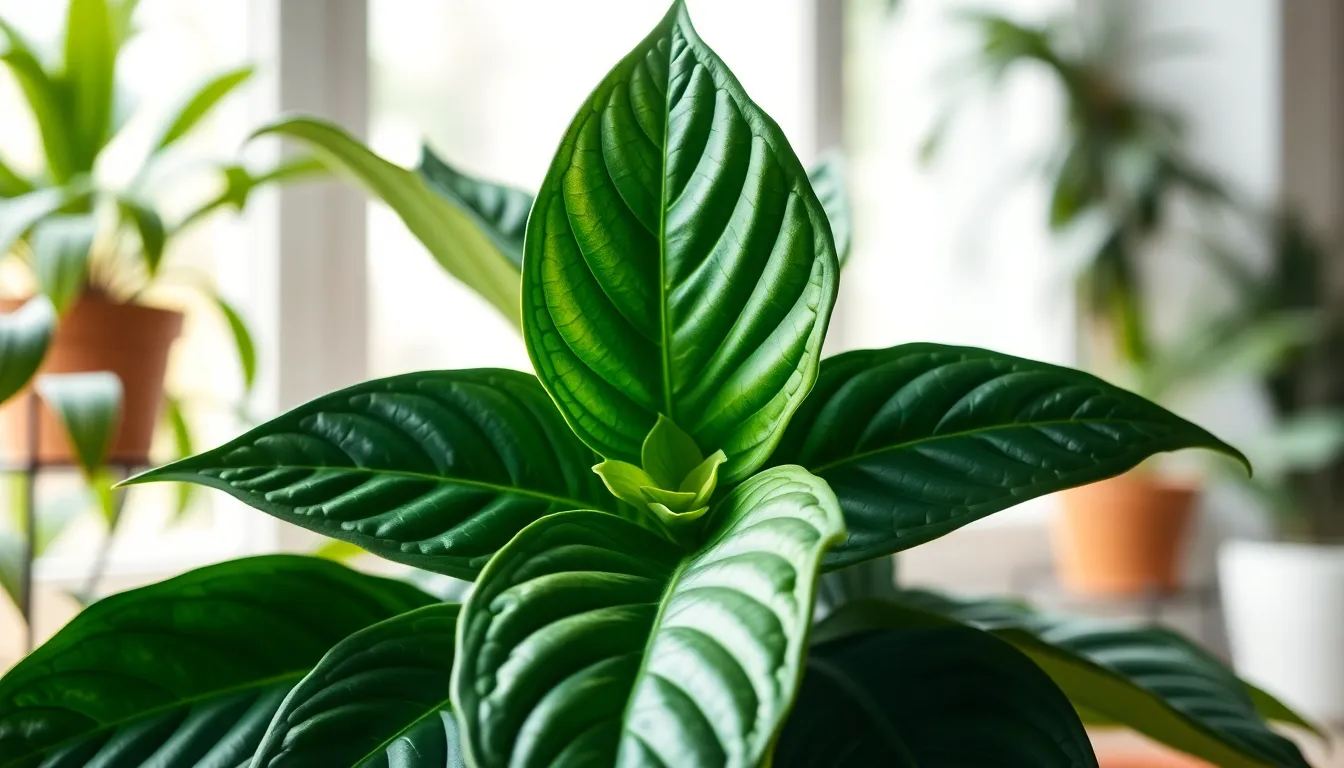
The Philodendron Hope stands out with its dramatic presence and unique self-heading growth pattern. This spectacular variety creates a bold architectural statement that transforms any indoor space.
Architectural Leaf Shapes
Deeply lobed leaves create the most distinctive feature of Philodendron Hope, earning it the nickname “Lacy Tree Philodendron.” Each leaf develops intricate splits and cuts that give the plant its characteristic tree-like appearance. The mature foliage can resemble a horse’s head or fiddle shape, which explains its alternative names “Horsehead Philodendron” and “Fiddleleaf Philodendron.”
Large sculptural leaves can reach impressive dimensions, creating a bold tropical statement in any room. The deeply dissected foliage provides excellent texture contrast when paired with plants featuring simpler leaf shapes like heart-shaped varieties. Each leaf emerges as a solid form before developing its signature splits as it matures.
Self-heading growth distinguishes this variety from vining philodendrons, as it grows upward from a central crown rather than trailing or climbing. This growth habit creates a compact yet dramatic silhouette that works perfectly as a standalone specimen plant. The leaves radiate outward from the center, forming an impressive rosette pattern.
Mature Plant Size Considerations
Indoor height potential reaches up to 8 feet tall, making this one of the largest philodendron varieties for indoor cultivation. We recommend measuring your ceiling height before adding this variety to your collection, as it requires substantial vertical space to reach its full potential. Most indoor specimens achieve their maximum height within 3-5 years under optimal conditions.
Outdoor growth capacity can exceed indoor dimensions significantly when planted in suitable climates. The plant develops an even more impressive stature in tropical and subtropical environments. Container cultivation helps control size while maintaining the plant’s architectural appeal.
Space requirements include both vertical and horizontal considerations, as the large leaves spread outward considerably. We suggest allowing at least 4-6 feet of clearance around the plant for proper air circulation. Regular pruning can help maintain manageable proportions in smaller indoor spaces without compromising the plant’s natural beauty.
Room placement works best in areas with high ceilings and ample floor space, such as living rooms, atriums, or large offices. The dramatic foliage serves as a natural room divider or focal point. Consider the plant’s mature dimensions when selecting containers and permanent locations.
Conclusion
We’ve explored an incredible diversity of philodendron varieties that can transform any living space into a lush tropical paradise. From the beginner-friendly Heart-Leaf to the dramatic Tree Philodendron each type offers its own unique characteristics and growing requirements.
Whether you’re drawn to the vibrant color changes of the Prince of Orange or the velvety texture of Micans there’s a philodendron perfectly suited to your style and experience level. These adaptable plants continue to captivate us with their stunning foliage and forgiving nature.
The industry of philodendrons offers endless possibilities for creating beautiful indoor gardens. We encourage you to experiment with different varieties and discover which ones bring the most joy to your home.
Frequently Asked Questions
What makes philodendrons good houseplants for beginners?
Philodendrons are incredibly adaptable and forgiving, making them perfect for novice plant parents. They tolerate various light conditions, have straightforward watering requirements, and show clear signs when they need care. The Heart-Leaf Philodendron is especially beginner-friendly with its cascading growth and distinctive heart-shaped leaves that add instant charm to any space.
How do I maintain the variegation in my Philodendron Brasil?
To keep your Brasil’s vibrant green and yellow streaks, provide bright, indirect light. Too little light causes the plant to revert to solid green leaves, while direct sunlight can burn the delicate variegated portions. Rotate the plant regularly to ensure even light exposure and maintain consistent watering without overwatering.
Why are the leaves on my Split-Leaf Philodendron developing holes?
The holes and splits in your Monstera deliciosa leaves are completely natural! This process, called fenestration, occurs as the plant matures. Young plants have solid leaves, but as they grow larger and receive adequate light, they develop the characteristic “Swiss cheese” appearance that makes them so distinctive and popular.
How much space does a Tree Philodendron need indoors?
Tree Philodendrons (Selloum) can reach up to 8 feet tall and equally wide indoors, requiring substantial vertical and horizontal space. They need room for their large, deeply lobed leaves to spread naturally. Consider ceiling height and surrounding furniture when placing them, and be prepared to prune regularly to maintain manageable proportions in smaller spaces.
What’s special about the Pink Princess Philodendron’s coloration?
The Pink Princess features stunning heart-shaped leaves with unique pink and green variegation patterns – no two leaves are identical! The vibrant pink coloration requires adequate indirect light to maintain its intensity. Insufficient light causes the pink to fade and increases green leaf production, diminishing the plant’s prized variegated appearance.
How fast do Philodendron Micans grow?
Philodendron Micans are rapid growers that produce new leaves regularly during the growing season. Their velvety, heart-shaped leaves create a cascading growth habit perfect for hanging baskets or climbing supports. The fine hairs on the leaves give them a unique tactile experience and create a beautiful shimmering effect in proper lighting.
What’s the difference between climbing and self-heading philodendrons?
Climbing philodendrons like Brasil and Pink Princess produce trailing vines that need support structures, while self-heading varieties like Xanadu and Hope grow in compact, upright clusters. Self-heading plants form dense, symmetrical shapes without spreading horizontally, making them ideal for limited indoor spaces and container gardening applications.
When is the best time to propagate philodendrons?
Spring and summer are optimal for philodendron propagation when plants are in their active growth phase. During these months, stem cuttings root faster and more successfully. You can use water propagation, direct soil planting, or air layering methods. Avoid propagating during winter dormancy periods when growth slows significantly.
How do I support climbing philodendrons properly?
Climbing varieties like the Blushing Philodendron need vertical structures such as moss poles, trellises, or wooden stakes. Train the vines by gently wrapping them around supports and securing with soft ties. The nodes along the stems will naturally root into the support structure, helping the plant climb and creating a fuller, more attractive appearance.
What makes Philodendron Xanadu ideal for small spaces?
Xanadu’s compact, self-heading growth pattern creates dense clusters of deeply lobed leaves in a symmetrical silhouette. Unlike trailing varieties, it grows upward and outward in a controlled manner, making it perfect for apartments and small rooms. Its manageable size and stable growth work well in containers and mixed plant arrangements.

